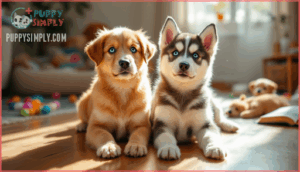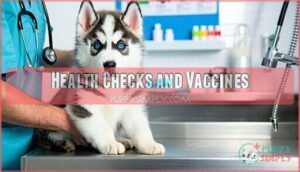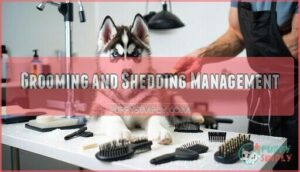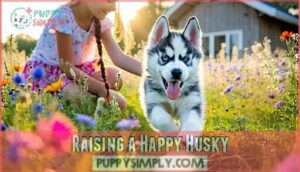This site is supported by our readers. We may earn a commission, at no cost to you, if you purchase through links.
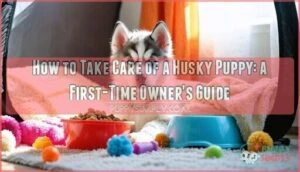
Feed them quality puppy food 3-4 times daily, and don’t skip regular vet visits for vaccines and checkups.
Huskies are smart (and stubborn!), so start training early with patience and consistency.
They’ve got energy to spare, so daily exercise is a must—think walks, playtime, or even some light jogging.
Their double coat sheds like a snowstorm, so weekly brushing will save your furniture.
Puppy-proof your home because huskies love exploring—and chewing.
With love, structure, and plenty of activity, your husky puppy will thrive.
Ready for the adventure of a lifetime?
Table Of Contents
- Key Takeaways
- Husky Puppy Essentials
- Caring for Husky Puppies
- Health Checks and Vaccines
- Feeding and Nutrition Tips
- Training and Socialization
- Grooming and Shedding Management
- Raising a Happy Husky
- Frequently Asked Questions (FAQs)
- How to take care of a Husky puppy for beginners?
- Is a Husky good for a first time owner?
- Is it okay to leave a Husky alone for 8 hours?
- Are huskies hard to take care of?
- How many times do you feed a husky puppy?
- Do huskies like to run away?
- What climate is best suited for a Siberian Husky?
- How to handle husky vocal behaviors?
- When do huskies reach full size?
- How to travel with a husky puppy?
- Conclusion
Key Takeaways
- Start early with vet visits, vaccinations, and a proper feeding schedule to keep your husky puppy healthy and happy.
- Socialize your puppy between 8-16 weeks and use positive reinforcement to teach basic commands and develop good behavior.
- Huskies need daily exercise, mental stimulation, and safe spaces to burn off energy and prevent boredom-driven mischief.
- Brush weekly to manage shedding, puppy-proof your home to avoid accidents, and stay consistent with training to build trust and structure.
Husky Puppy Essentials
When bringing home a husky puppy, it’s essential to prepare for their specific needs.
From health care to proper training, having the right basics will set your pup up for a happy and healthy start.
Veterinary Care and Health Monitoring
Establishing strong veterinary care is the key to great husky puppy health.
Strong veterinary care sets the foundation for a healthy, thriving husky puppy with fewer surprises along the way.
Schedule monthly vet visits during their first four months to maintain a proper vaccination schedule and monitor early health.
Huskies are prone to hip dysplasia and eye disorders, so regular check-ups and genetic screening are essential.
Don’t forget parasite prevention—heartworms, fleas, and ticks can cause serious issues.
Keep an eye out for warning signs like vomiting or lethargy.
Breeder health testing guarantees your pup starts with a clean slate, supporting their long-term well-being.
Proactive dog health screening means fewer surprises down the road.
Nutrition and Feeding Requirements
Your husky puppy thrives on high-quality puppy food with 25-30% protein to fuel their active lifestyle.
Feed 2-3 cups daily, dividing it into three meals until they’re about four months old.
Fresh water should always be within paw’s reach—especially during hot days.
A proper feeding routine guarantees glossy coats, bright eyes, and a happy, healthy pup.
Many owners find specialized puppy food beneficial for huskies.
A proper feeding routine guarantees glossy coats, bright eyes, and a happy, healthy pup.
- Stick to a Feeding Schedule: Consistent mealtimes keep digestion on track.
- Control Portions Carefully: Avoid underfeeding or overfeeding.
- Monitor Growth Weekly: Adjust their food as they grow.
- Avoid Toxic Foods: Foods like chocolate, grapes, and onions are harmful.
- Raw Feeding Caution: Consult your vet before considering this option.
Balanced nutrition now sets your puppy up for a strong future.
Training and Socialization Needs
Training your husky puppy early is a game-changer for their behavior.
Training your husky puppy early sets the stage for a lifetime of good behavior, trust, and a strong bond.
Start with puppy socialization between 8-16 weeks; this is when they’re most open to new people, pets, and environments.
Teach basic commands like “sit” and “stay” using positive reinforcement—treats and praise work wonders!
Introduce leash manners by practicing no-pull techniques around 12-16 weeks.
Huskies can be determined, so set boundaries from day one with a fair yet firm approach.
Daily mental stimulation, like puzzles or games, helps manage their energy.
Consider obedience classes to reinforce good habits.
Early socialization and training build a well-mannered, confident companion you’ll enjoy for years.
Caring for Husky Puppies
Caring for your new Husky puppy starts with making your home safe—hide loose wires and small objects to prevent accidents.
These energetic and smart pups thrive on daily mental stimulation like puzzle toys and husky puppy training games.
Plan for at least an hour of Puppy Exercise each day to keep them happy.
Their Breed Temperament is friendly but stubborn, so patience is key.
Stick to a consistent husky puppy food plan and socialize early to shape a confident, well-mannered companion.
Health Checks and Vaccines
Keeping up with health checks and vaccinations is key to raising a healthy Husky puppy.
Regular visits to the vet help catch potential issues early and guarantee your pup stays protected against common diseases.
Schedule and Timeline
Keeping track of your pup’s vaccination timeline is part of husky puppy care.
Here’s a quick vaccination schedule to keep your little adventurer protected:
- 6-8 weeks: First DAP shot; add Bordetella if needed.
- 10-12 weeks: Second DAP vaccine; consider Leptospirosis.
- 14-16 weeks: Final DAP and first Rabies.
- 1 year: Boosters to keep immunity strong.
Common Health Issues in Huskies
Your puppy’s boundless energy comes with some health challenges.
Pay close attention to these husky health issues for early detection and care.
| Condition | Symptoms to Watch | Action Needed |
|---|---|---|
| Hip Dysplasia | Limping, stiffness | Vet check, weight management |
| Eye Disorders | Vision changes, redness | Annual eye exams, possible surgery |
| Hypothyroidism | Hair loss, weight gain | Blood tests, lifelong hormone therapy |
| Autoimmune Diseases | Skin lesions, lethargy | Diagnosis by vet, specialized treatment |
Understanding these breed-specific issues guarantees your Husky thrives!
Preventative Care Measures
Preventing problems is the heart of husky puppy health care.
Protect your pup with these proactive steps:
- Parasite Control: Keep heartworms, fleas, and ticks at bay with monthly parasite prevention.
- Dental Hygiene: Start brushing their teeth early—good habits now mean fewer vet bills later.
- Home Safety: Puppy-proof your space. A curious husky can find trouble in a heartbeat!
- Genetic Screening: If your breeder skipped it, consider testing to spot hereditary risks early.
Early action, from husky puppy vaccinations to booster shots, builds their immunity and guarantees lifelong health.
Feeding and Nutrition Tips
Feeding your husky puppy the right food in proper portions is essential for their growth and energy.
With a consistent schedule and quality nutrition, you’ll set them up for a happy, healthy start.
Choosing The Right Food
Choosing the right diet for your husky puppy starts with high-quality puppy food.
Look for protein source matters like chicken, lamb, or fish listed as the first ingredients. The best brands for husky puppy nutrition, such as Merrick or Royal Canin, offer balanced meals that meet their needs.
Reading food labels helps you avoid fillers like corn or soy. You can find a variety of husky puppy food options online.
A varied husky puppy diet might include dietary supplements—discuss options with your vet for dog nutrition matched to their growth and energy levels.
Feeding Schedule and Portion Control
A good feeding routine is key to your husky puppy’s health.
Start with four meals daily (8-12 weeks), reduce to three (3-5 months), and settle at two meals (6+ months).
Offer 2-3 cups of high-quality puppy food daily, adjusting portions based on your dog’s weight and appetite.
Stick to proper puppy meal frequency to prevent tummy troubles and support growth.
Include treat calorie inclusion in their daily needs, and focus on a balanced husky puppy diet.
Monitoring Growth and Weight
Healthy development starts with your pup’s growth compass—weekly checks on weight and body condition. You should feel their ribs, not see them.
Huskies grow fast, gaining 1-2 pounds per week until six months. Track healthy growth with husky-specific weight charts and adjust portion sizes if needed.
Use these steps for healthy development:
- Monitor body condition—you’ll spot changes early.
- Consult growth milestones regularly.
- Adjust puppy calorie needs for proper puppy meal frequency.
Training and Socialization
Training your Husky puppy is key to raising a well-behaved and confident dog, so start early with basic commands and positive reinforcement.
Socializing them with people, pets, and new environments will help prevent unwanted behaviors and build their confidence.
Basic Commands and Obedience
Teaching basic commands to your husky puppy takes time and patience. Start with crate training and recall training in safe spaces, layering in leash manners gradually.
Use positive reinforcement like treats and praise, as Huskies thrive on encouragement. Addressing stubbornness means staying consistent—short, enjoyable sessions work best.
Redirect chewing to toys early on, building obedience and trust through repetition. Consistent training guarantees long-term success.
Socializing With Humans and Other Animals
Getting your husky puppy socialized starts with early introductions to people and animals. Promote positive associations by exposing them to different experiences in controlled environments. Huskies thrive when properly socialized, so guide them to interact politely.
- Enroll in puppy kindergarten at 8 weeks.
- Organize supervised playdates with friendly dogs.
- Introduce to diverse people calmly.
- Watch for breed differences in social behavior.
- Reward good behavior consistently.
Addressing Behavior Issues
When your Husky puppy starts husky puppy biting or exhibits destructive chewing, it’s often due to boredom or teething.
Provide chew toys and plenty of exercise. For separation anxiety or excessive barking, create a soothing routine. Manage leash reactivity with patience and no-pull techniques.
If resource guarding occurs, don’t punish—use rewards to shape calm behavior.
| Issue | Possible Cause | Solution |
|---|---|---|
| Destructive Chewing | Teething/Boredom | Chew Toys, Exercise |
| Separation Anxiety | Fear of Loneliness | Soothing Routine, Training |
| Excessive Barking | Stress/Boredom | Calm Routine, Stimulation |
| Leash Reactivity | Fear/Stubbornness | No-Pull Techniques, Treats |
Grooming and Shedding Management
Keeping your Husky puppy’s coat healthy takes regular grooming, especially with all that shedding.
You’ll need to brush frequently, bathe occasionally, and manage all the fur that seems to appear everywhere, which involves regular grooming to keep their coat healthy.
Brushing and Bathing Techniques
Taking care of your husky puppy’s double coat guarantees their fur stays healthy and beautiful.
Regular brushing reduces heavy shedding and prevents matting, especially during coatblowing seasons. Use a slicker brush and an undercoat rake for grooming tools that help manage shedding frequency. You can find the right brush for your husky to maintain their coat.
- Brush daily to minimize loose fur and tangles.
- Bathe every 2-3 months with a gentle shampoo selection to protect natural oils.
- Dry thoroughly with a high-velocity dryer to preserve their water-resistant topcoat.
- Inspect their fur during grooming for any signs of irritation or skin issues.
Consistency keeps your puppy’s coat shiny and manageable!
Nail Trimming and Paw Care
Keeping your husky puppy’s paws healthy and nails trimmed is key to injury prevention and good mobility.
Use proper dog grooming tools like a guillotine clipper every 1-2 weeks to maintain nail trimming frequency. Clean paw pads with a damp cloth after walks to remove debris.
During winter, apply paw balm weekly for added protection. If nail trimming feels tricky, consider a professional grooming visit.
Short nails and clean paws mean a happy, comfortable pup with good mobility!
Managing Shedding and Coat Care
Every Husky owner faces the legendary coat-blowing season, where fur seems endless.
Groom your pup 3-4 times weekly with an undercoat rake to control shedding. Never shave their double coat—it protects skin health and keeps their temperature steady.
Bathing every 2-4 months with specialized shampoos helps reduce shedding frequency.
- Grooming tools like slicker brushes are lifesavers.
- Keep skin healthy with gentle shampoos.
- Brush daily during heavy shedding.
Raising a Happy Husky
Raising a happy Husky means creating the right balance of care, structure, and fun.
You’ll need to provide a safe home, plenty of exercise, and consistent routines to help your energetic pup thrive.
Creating a Safe and Comfortable Environment
Your pup’s first home should feel as safe as a cozy den. Start by puppyproofing—secure cords, block escape routes, and stash harmful items.
A comfy bed in a quiet, draft-free spot offers rest.
Outdoors, a high, sturdy fence prevents Houdini-like escapes. Always think hazard awareness: no toxic plants, no choking toys, just a secure yard where curiosity stays safe.
Providing Mental Stimulation and Exercise
Your husky puppy’s exercise needs go beyond a good run—they need activities that challenge their sharp mind too!
Try these ideas to keep your pup engaged:
- Puzzle Toys: Mealtimes become brain workouts when you add these.
- Agility Training: Set up low hurdles or tunnels for fun backyard play.
- Scent Work: Hide treats for a sniffing adventure.
- Off-Leash Activities: Safe environments keep the energy burning!
- Interactive Games: Games like tug or fetch strengthen bonds.
Building a Strong Bond and Relationship
Strengthen your bond with your husky by focusing on trust building and consistent communication.
Engage in daily playtime activities like fetch or tug-of-war—they’re not just fun but essential for creating shared memories.
Learn to read their cues, like tail wags or vocalizations, to understand their needs, and show affection through gentle pets and praise; it reassures them.
Positive reinforcement and shared activities make life enjoyable for both new husky owners and their playful pups.
Frequently Asked Questions (FAQs)
How to take care of a Husky puppy for beginners?
Imagine managing a whirlwind on four legs!
Start with regular vet visits, quality puppy food, and early training.
Socialize generously, brush often, and don’t skip grooming.
Huskies need consistency, love, and lots of exercise!
Is a Husky good for a first time owner?
Huskies can be a handful for first-time owners.
They’re smart, stubborn, and high-energy, needing consistent training, exercise, and patience.
If you’re committed to learning and adapting, they can make a rewarding and loyal companion.
Is it okay to leave a Husky alone for 8 hours?
Leaving a Husky alone for 8 hours is risky.
They’re like bored geniuses; they’ll find mischief!
Huskies need interaction, exercise, and mental stimulation.
Consider a dog walker or daycare to keep them entertained and happy.
Are huskies hard to take care of?
Taking care of a husky can be challenging.
They’re high-energy, shed constantly, and need consistent training.
However, with patience and proper care, you’ll find their loyalty and affection absolutely worth it.
How many times do you feed a husky puppy?
Feed your husky puppy 3-4 times a day, depending on their age.
Split their daily food portions evenly.
By six months, switch to two meals per day.
Always provide fresh water and monitor their appetite.
Do huskies like to run away?
You might notice your Husky’s curious spirit and love for adventure.
They’re known escape artists, so secure your yard and supervise them outdoors.
Consistent training and exercise help curb their wandering instincts and keep them safe.
What climate is best suited for a Siberian Husky?
Did you know Huskies thrive in temperatures as low as -50°F?
They prefer cold, snowy climates but can adapt to moderate ones.
Just keep them cool in heat—plenty of shade, water, and air conditioning help.
How to handle husky vocal behaviors?
Huskies love to "talk," so embrace their chatty side by responding calmly.
Use commands like “quiet” for excessive noise, reward quiet moments, and make certain mental and physical activity to prevent boredom-driven howls or whines, which can be addressed by using “quiet” commands.
When do huskies reach full size?
Picture your husky bounding through snow, sleek and strong.
They usually reach their full size between 12-18 months.
Males grow larger, around 21-24 inches tall, while females typically reach 20-22 inches.
It’s breathtaking!
How to travel with a husky puppy?
Pack essentials like a travel crate, water, food, and toys.
Take breaks frequently for potty and playtime.
Use a harness for safety, and keep their energy burned off with walks or games.
Conclusion
Ready to begin the journey of raising a husky puppy? With their boundless energy and sharp minds, huskies thrive when you provide love, structure, and plenty of activity.
By focusing on proper training, grooming, and feeding, you’ll set the stage for a happy, healthy life together.
Don’t forget regular vet visits and socialization—both are key! As a first-time owner, this guide on how to take care of a husky puppy will help you navigate every step.




